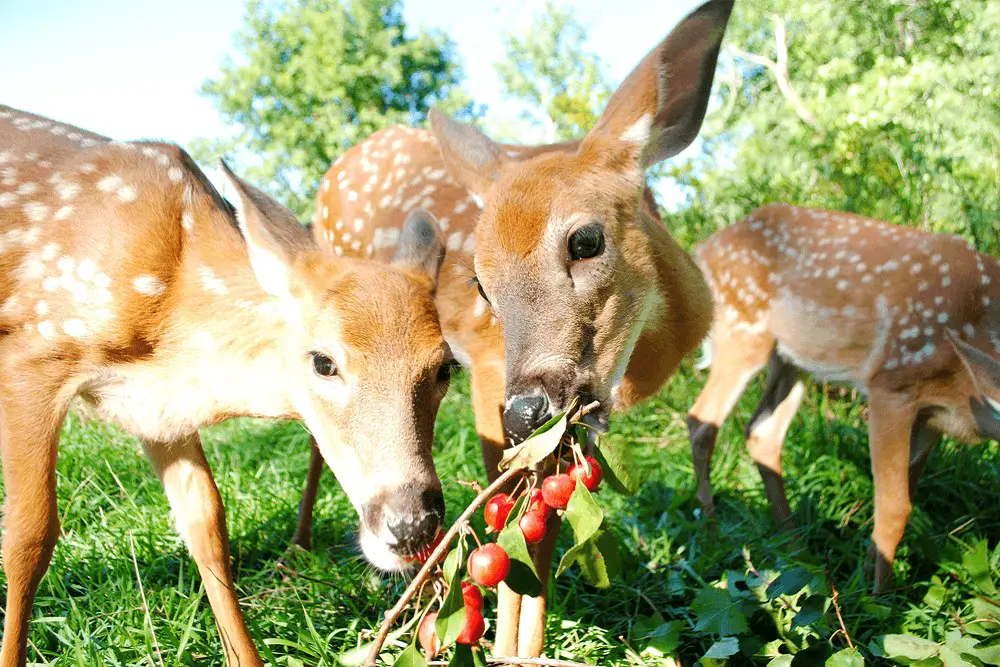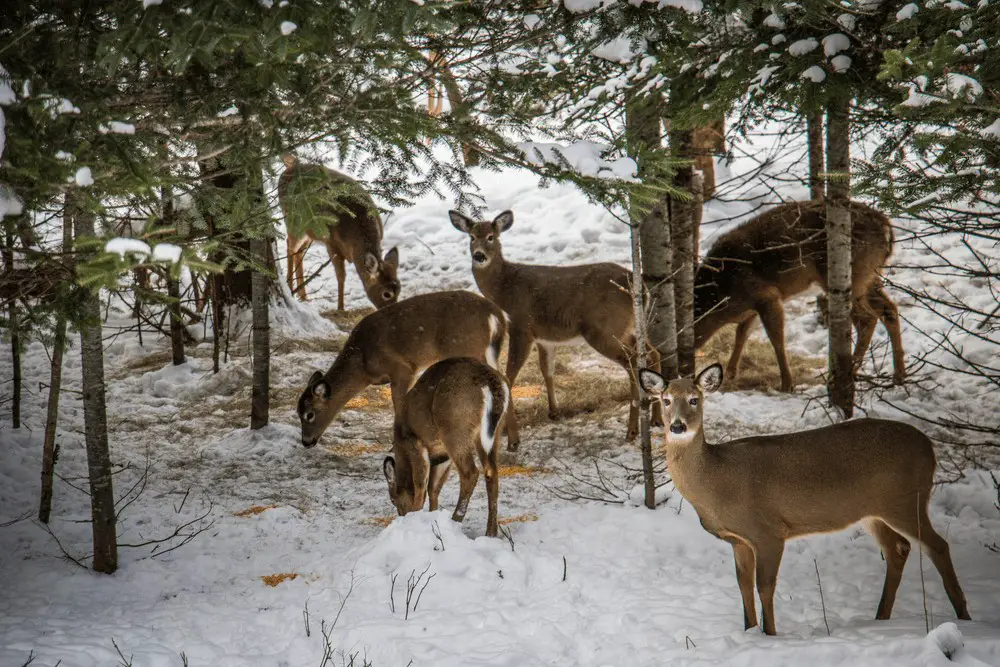People who fail in deer season are people who fail to study deer behavior.
Getting out in the woods is a luxury and missing a deer this season doesn’t mean starvation as it did with our ancestors.
You can bet that Native Americans and Longhunters took the time to understand their quarry to ensure their hunts were successful. If your goal is to take a deer this season, your best bet is to emulate our hunting forefathers and take the time to understand deer behavior.
Like most living things, deer will be mostly driven by the need for food. Survival is a calorie game that is pre-programmed into animal behavior.
Deer will seek specific food sources as the seasons change. This goes beyond eating what’s available, the gut microbes of a deer change to accommodate specific types of food as the seasons change. This selectivity makes them highly predictable.

Overview
Just because a deer is an herbivore doesn’t mean that it can eat what all herbivores eat. Unlike cows and other roughage eaters, deer lack the large fore-stomach to graze. They instead belong to a class of herbivores called Concentrate Selectors which are more like a scavenger who will pick at smaller plants and move great distances in search of food sources.
Adult deer have about a 2-gallon stomach and will scrounge for any food they can to keep it filled, often eating constantly or at least every 3 to 4 hours. Throughout the year a deer will eat buds, shoots, flowers, mushrooms, nuts, fruits, berries, young leaves, and even some cacti.
As the seasons move toward winter, a deer will look for the most calorie-dense foods available and focus more on some specific nutrients in preparation. Knowing exactly what food sources are prime at any given time is a matter of geography, climate, and local deer biology but some generalities exist.
Spring
After winter, deer are most likely still in a starvation state and will be scavenging for any food they can find. The most common class of food is referred to as Browse which consists of shoots, young leaves, buds, twigs, and some early-growth grasses. Food is still sparse and deer will need to range widely if they want a full stomach.
The fawning season typically happens around the time of greatest bloom. While rearing young, access to food is vital. While Browse is still a choice food source, deer begin to feed on Forbs which are a type of flowering herbaceous plant. Mushrooms, a preferred food of deer, are vitally important in spring for proper bone and antler development.
Some food sources to look out for at this time of year are aspen, white cedar, beech, maple, hemlock, dogwood, sassafras, greenbrier, honeysuckle, supplejack, and any weeds that are not grasses, sedges, or rushes, especially flowering ones. Open fields, especially those with lots of wildflowers will be common deer feeding grounds.
Summer
Though we often equate spring to the time of maximum growth, summer is really the season where food is most abundant. Fruits, berries, and nuts, called Mast, are vital summer foods for deer. These are carb and protein-rich energy sources and will make up the majority of a deer’s diet. Mushrooms are still an important nutrient source as well as naturally occurring legumes.
This is also the time when deer begin to raid farm crops, this is spawned by a natural tendency to roam less and find food rich areas near water sources. Browse remains a viable snack but with more sedentary behavior taking the lead, look for naturally occurring berry bushes, flowering shrubs, and fruit trees with tender leaves to find deer.
Common food sources in summer are Blackberry, raspberry, serviceberry, wild grapes, wild strawberries, staghorn or skunkbush sumac, and any summer flowering plants like jewelweed. Deer will also graze poison ivy and oak regularly. Expect deer to stay under the tree canopy as much as possible.
Fall
Fall forage is all about sugars. In early fall expect deer to congregate around fruit and nut trees which offer both carbohydrates and proteins to get them ready for the sparse food availability of winter. Other prime choices are cereal grains like corn and wild alfalfa. As deer seek to pack on pounds, they will begin to roam more to find the best food options. Fall is a time of voracious eating.
Heading into the rut of late fall, male deer will stop eating and can lose up to 20% of their body mass. Doe will continue to eat any Mast they can find and begin to slowly transition back to eating Browse and late falling nuts like acorns and chestnuts.
In the fall, choice foods are beechnuts, acorns, apples, pears, persimmons, wild grains, mushrooms, and any late fruit crops. Late fall, deer may also begin to strip bark from aspen and birch trees if food is really sparse.
Winter

For most of the country, winter is a time of starvation. Doe may struggle to gather enough nutrients for the young they are carrying. Bucks will already be in a starvation mode after rut and will eat any food source they can find. Throughout winter, deer will be feeding mostly on Browse but will take any opportune food they can find.
Some nuts and cereal grains will hang on until late winter and are prime places for deer to feed. Forests thick with oak, beech, or hickory are great locations. Even though food is sparse, deer are more sedentary in winter to conserve calories instead of roaming in search of food. Winter is a tough time in the animal kingdom, especially for such selective feeders as deer.
Anything edible will do in winter but common foods are hard nuts like acorns, beechnuts, hickory nuts, buckeye, chestnuts, or butternuts. Some fruits, even though mostly rotten, will still serve as a meal. Twigs and bark that can provide some calories will do when no other foods are available. This is a time of scavenging. If you find anywhere with a lot of fallen fruits or nuts, it is sure to attract deer. Areas around the edges of fields where grain crops were common in the fall will be thoroughly picked over by the end of winter.
Conclusion
There is a local hunting lease that if scouted during the summer and early fall would show almost no sign of deer. It would look like some of the worst hunting grounds in the country. That all changes in mid to late fall when the deer arrive in droves and stay till late spring or early summer. If you understand the local deer population, you can predict this behavior.
The lease is surrounded by plentiful, secluded farmlands that offer far better forage in the warmer months and around harvest so the deer all leave to forage those areas. Around late October, all of those food sources are harvested the deer will begin searching for new feeding grounds.
The hunting lease is full of oak, hickory, and beech trees with the occasional Crab apple. There are open spaces covered in greenbrier and a blackberry. Though most of the fruit has fallen, it’s still edible and the deer come in droves just in time for deer season and rut and will stay over winter. The unaware hunter would have ruled out this hunting ground months before the deer arrived but a hunter who understands feeding and migratory deer behavior will be waiting for them.
Many of the places you see a lot of deer signs in the summer will be vacant by late fall. Head out to your local hunting grounds and pay close attention to the available food. Try to predict when the deer will be most likely to feed there. There is no need to bait deer when Mother Nature does it for you. A little study will go a long way or you could just rely on luck and risk missing out this year.
Feeding is just one behavior that can help you in your search for deer but it may be one of the best. Taking the time to study their mating and birthing habits will also serve you well. As a hunter knowing a deer’s prey behavior is very useful. It’s all a part of painting a picture that will not only lead you to deer but to the trophy buck you are looking for. This is all just an introduction to a skill set that will ensure you never have a tag left at the end of the season.

Very helpful, followed the advice and took a 6 pt buck this morning. Nov 15 2018. Thanks